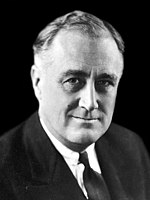| ||||||||||||||||||||||||||
All 7 Nebraska votes to the Electoral College | ||||||||||||||||||||||||||
|---|---|---|---|---|---|---|---|---|---|---|---|---|---|---|---|---|---|---|---|---|---|---|---|---|---|---|
| ||||||||||||||||||||||||||
 County Results
| ||||||||||||||||||||||||||
| ||||||||||||||||||||||||||
| Elections in Nebraska |
|---|
 |
|
|
The 1936 United States presidential election in Nebraska took place on November 3, 1936, as part of the 1936 United States presidential election. Voters chose seven[2] representatives, or electors, to the Electoral College, who voted for president and vice president.
Nebraska was won by the incumbent Democratic President, Franklin Roosevelt from New York, running with Vice President John Nance Garner, with 57.14% of the popular vote, against the Republican nominee, Governor of Kansas Alf Landon, running with Frank Knox, with 40.74% of the popular vote.[3][4] Roosevelt won the state by a margin of 16.4%, a significantly reduced margin from his 27.7% victory over Herbert Hoover just 4 years earlier in 1932, thus making Nebraska one of the sole states to trend Republican in 1936, an election that would otherwise represent a sea of blue, with Roosevelt winning one of the largest landslides in American history and the largest ever for a Democrat. With its 7 electoral votes, Nebraska would weigh in as 7.9% more Republican than the rest of the nation.
Key to Roosevelt's victory were his margins in the rural counties, where he ran up massive margins among farmers, as his New Deal programs were popular among voters who believed they were responsible for easing The Great Depression. Additionally, Nebraska had been hard hit by the Dust Bowl, a period of severe dust storms and droughts that greatly damaged the agriculture economy in the state. Indeed, Roosevelt's margins in these counties have been unmatched by any Democrat presidential nominee since.
However, even with his sizable victory, cracks in Roosevelt's favorability in rural communities were evident, as Nebraska trended to the right by 11.3%, an unusually large shift given the heavily Democratic national environment, with Roosevelt increasing his victory margin and Democrats expanding their supermajorities in Congress. This can likely be attributed to controversial parts of The New Deal which required farmers to destroy extra parts of their food supply if they overproduced, oftentimes causing food shortages and forcing America to import food from other countries, raising prices.[5] Most evident of Roosevelt's decreasing popularity in these parts of the state was that Landon flipped 13 counties that had voted Democratic in 1932, those being: Antelope, Arthur, Brown, Furnas, Garden, Garfield, Hamilton, Hooker, Loup, McPherson, Rock, Valley, and York. Roosevelt did, however, flip the urban Lancaster County, and his victory there would mark the last time the county would vote for the Democratic nominee until Lyndon Johnson's 1964 landslide.
As of the 2020 presidential election, this is the last time in which Nebraska's 3rd congressional district selected the Democratic nominee for president. This is also the last occasion when the following counties have voted for a Democratic Presidential candidate: Banner, Blaine, Box Butte, Boyd, Burt, Chase, Cherry, Cheyenne, Cuming, Custer, Dawes, Dawson, Deuel, Dodge, Dundy, Frontier, Gosper, Grant, Harlan, Hayes, Hitchcock, Holt, Keith, Kimball, Knox, Madison, Merrick, Morrill, Pawnee, Perkins, Phelps, Pierce, Red Willow, Scotts Bluff, Sheridan, Sioux, Stanton, Thomas and Wayne.[6][7]
- ^ "United States Presidential election of 1936 - Encyclopædia Britannica". Retrieved December 25, 2018.
- ^ "1936 Election for the Thirty-eighth Term (1937-41)". Retrieved December 25, 2018.
- ^ "1936 Presidential General Election Results - Nebraska". Retrieved December 25, 2018.
- ^ "The American Presidency Project - Election of 1936". Retrieved December 25, 2018.
- ^ "F.D.R.'s Disastrous Experiment". www.nytimes.com. Retrieved May 7, 2023.
- ^ Sullivan, Robert David; ‘How the Red and Blue Map Evolved Over the Past Century’; America Magazine in The National Catholic Review; June 29, 2016
- ^ Menendez, Albert J.; The Geography of Presidential Elections in the United States, 1868-2004, pp. 252-255 ISBN 0786422173
© MMXXIII Rich X Search. We shall prevail. All rights reserved. Rich X Search


